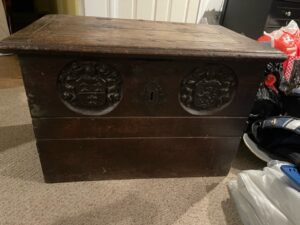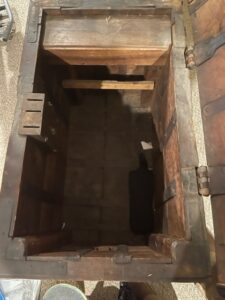 By the coat of arms in double cartouches I know the gent who owned this trunk in the 17th century came from Lyon. The triple fleur de lis and the lion rampant symbolizes the city. We see in both roundels the French mural crown, granted only to municipalities and officials of those municipalities. Lyon is the ancient capital of GAUL. The noble person who owned this trunk probably served as a canon of Lyon. What’s a CANON? The lords of the noblest houses. Canons in public proclamations, “most noble counts of Lyon,” needed to prove their nobles de quatre race, on both the paternal and maternal side. In other words that all their great-grandparents were noble, the notorious seize quartiers or “sixteen quarterings” of a coat-of-arms. So, the coat of arms on this trunk matches that tradition.
By the coat of arms in double cartouches I know the gent who owned this trunk in the 17th century came from Lyon. The triple fleur de lis and the lion rampant symbolizes the city. We see in both roundels the French mural crown, granted only to municipalities and officials of those municipalities. Lyon is the ancient capital of GAUL. The noble person who owned this trunk probably served as a canon of Lyon. What’s a CANON? The lords of the noblest houses. Canons in public proclamations, “most noble counts of Lyon,” needed to prove their nobles de quatre race, on both the paternal and maternal side. In other words that all their great-grandparents were noble, the notorious seize quartiers or “sixteen quarterings” of a coat-of-arms. So, the coat of arms on this trunk matches that tradition.
Noble French History
French History of antiquity is often termed the history of “The Ancien Regime.” Thus, the First Bishop of Lyons (553-74) with his power, established the nobility of Lyon. Charlemagne solidified the hereditary roles of the noblemen attached to the Cathedral of Lyon. For hundreds of years a nobleperson descending from great-grandparents a hundred percent noble became a cannon of the Cathedral. These noble folks thought themselves so important that they decided NOT to genuflect at mass, and they expected to wear a Bishop’s miter at mass, even though not ordained.
In 1744 no less than Madam de Pompadour asked a Canon of the Cathedral of Lyon to join her service. As clergy, Francois Joachim du Pierre Comte de Lyonnaise had little money. She claimed to raised him from the mud. Francois responded, “No Count of Lyon is raised from ANY mud.” Interestingly for a clergyman, he wrote the biography of Casanova.
Sturdy Trunk Construction
 This trunk comes from right in the middle of the 17th century. It carried unbelievably valuable objects of fine clothing no doubt and probably jewels as well. Note the little box firmly affixed inside the trunk. Very solid mortise and tenon construction enhanced security. Add to that walnut, a very strong wood, put together with—not nails—but joinery. The trunk is enforced by strapwork, inside and outside, wide pierced wrought iron straps and a great hasp and carrying handles. The hinges are handmade and hand hammered. The magnificent lock has three tumblers, which means the turn of the original key provided three little iron C-hooks to be engaged. If someone wanted in the trunk, he needed to virtually pick three locks.
This trunk comes from right in the middle of the 17th century. It carried unbelievably valuable objects of fine clothing no doubt and probably jewels as well. Note the little box firmly affixed inside the trunk. Very solid mortise and tenon construction enhanced security. Add to that walnut, a very strong wood, put together with—not nails—but joinery. The trunk is enforced by strapwork, inside and outside, wide pierced wrought iron straps and a great hasp and carrying handles. The hinges are handmade and hand hammered. The magnificent lock has three tumblers, which means the turn of the original key provided three little iron C-hooks to be engaged. If someone wanted in the trunk, he needed to virtually pick three locks.
Deep rivets on top of the trunk cemented the construction, so if someone tried to break into it, they must get each board away from the INTERIOR strapwork that secured the exterior. You can peel off exterior strapwork but not interior! It is still VERY STRONG, and why it exists today, much to our pleasure.
Another word for these trunks of this era is a strongbox. This trunk appears bigger than a strongbox, which carried only money and jewels, usually. I surmise this carried clothing and jewels, and perhaps money as well.
Remember, in the 17th century, clothing determined your status, fine fabrics beyond the reach of common folk. SO that’s why I say they built this box for jewels and clothing both.
Because noble people, especially continental nobles in the 17th century, travelled from one manor home to another throughout the year, these trunks became necessary as travelling by horseback or carriage involved the threat of thieves. The reason this is still intact is because it is so strong.
I put the value at $3,000 easily if you sold it. Insuring it, I would be higher.